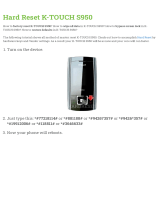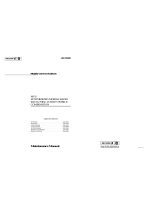
Excluding option boards, the basic radio mounted in a
cast aluminum frame. The two boards are the transmitter-
receiver-system (TRS) board 19D9901620G1 and the
power amplifier board (see Figure 1). The TRS board is
connected to chassis ground allowing it to be used in
vehicles with a negative ground battery system only. Op-
tion boards include the Channel Guard board and VG
Interface board. The VG Interface board is used in radios
equipped with Voice Guard.
FREQUENCY SYNTHESIZER
The frequency synthesizer consists of a microcom-
puter, electrically erasable PROM(S) (EEPROM), a fre-
quency synthesizer IC, transmit and receive VCO’s and
associated circuitry. The frequency synthesizer under con-
trol of the microcomputer generates all transmit and re-
ceive RF frequencies.
EEPROM
The EEPROM stores binary data for all RF frequen-
cies, Channel Guard tones/digital codes, and the timing
function of the Carrier Control Timer (CCT). The micro-
computer accesses the EEPROMS and provides the correct
WALSH bits to the Channel Guard board to generate the
correct Channel Guard tone or digital code on a per channel
basis.
PROGRAMMING
The EEPROM allows the radio to be reprogrammed as
needed to adapt to changing system requirements. RF fre-
quencies, Channel Guard tones and digital codes, and the
CCT function can be reprogrammed.
Depending on the configuration of the radio, one or
two EEPROMs may be provided. Radios not equipped with
a MODE A/B switch will have one EEPROM. Radios with
more than 16 channels and those with the MODE switch
will have two EEPROMs.
The EEPROMs can be reprogrammed through the
radio front connector using the General Electric Universal
PROM Programmer Model TQ2310. This programmer al-
lows all information to be loaded simultaneously.
Alternatively, a single channel Programmer Model
4EX22A10 allows the user to reprogram the radio on a per
channel basis. This programmer requires the removal of the
radio top cover and any option boards present. A special
programming jack, J711, is provided in the radio for inter-
connections.
Programming instructions are provided in the respec-
tive Programmer Maintenance Manuals.
TRANSMITTER
The transmitter consists of the exciter, frequency syn-
thesizer, TX VCO, and a power amplifier assembly. The
PA assembly consists of a PA board mounted along the side
of the radio next to the heat sink assembly. The PA board
also contains a hermetically sealed antenna relay and a low
pass filter.
RECEIVER
The receiver consists of the frequency synthesizer, RX
VCO, injection amplifiers, front end, IF and limiter detec-
tor. In UHS receivers, a pre-amplifier board is added in the
receiver front end. Audio and squelch circuitry for the
receiver is located in the system section of the TRS board.
Jacks for the Channel Guard and other structured options
are also located in the system area.
CONTROL UNITS
Several "S" series control units are available for use
with the DELTA-S radio combinations.
The S-500 control unit contains an on-off volume
control switch, a rotary channel selector switch for 1, 8, or
16 channels, a MODE A/B switch (optional) to expand the
channel select capability to 32, seven segment channel
indicator(s), a red transmit indicator, channel busy indica-
tor (optional), and an external tone option jack. Options
that may be used with this control unit include Type 90 and
99 tone, squelch operated relay SOR, GE-STAR encoder,
and public address.
The S-600 control unit contains an on-off volume
control switch, squelch disable switch, red transmit indica-
tor, and a seven segment channel indicator. A rotary chan-
nel select switch permits selection of up to eight channels.
A white power-on indicator is used for back lighting the
front panel. Space is provided for two optional push-button
switches and two optional indicators.
The S-900 series control units designed specifically
for the DELTA class radios are highly versatile, software
NOTE
When programming, remember that all RF frequen-
cies must be divisible by 12.5 kHz.
LBI-31567
8











